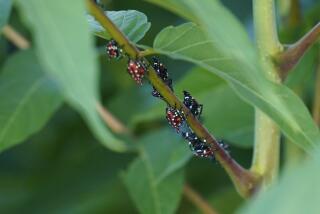Spotting Pests With Appetite for Tomatoes
- Share via
Question: Every year something eats the leaves of my tomato plants and takes bites of the fruit. I would like to prevent the damage this year, but I haven’t been able to locate and kill the pest. What do you suggest?
D.B., Huntington Beach
Answer: A variety of pests can attack tomato plants. Snails tend to feed on the surface of the fruit, and slugs tend to hollow it out. Rats have also been known to consume tomatoes.
The most likely culprits, however, are tomato hornworms. They tend to devour the leaves but leave the stems, and green fruit will probably have small to large gouged-out areas. Black droppings (frass) will often be apparent on both foliage and stems.
The tomato hornworm is the larvae of a large 4- to 5-inch brown moth with five orange spots on each side of its body. In late spring you might notice this moth laying pale green eggs singly on the underside of the leaves.
The larvae that hatch can grow up to 4 inches long, are green with diagonal white stripes and a single black horn on their tail end. These intruders also feed on dill, eggplants, peppers, potatoes and tomatillos.
Control of tomato hornworms requires the following:
* Careful observation to detect their presence because they blend in well with the foliage.
* If hornworms are detected early in the season (while they are small), biological control agents (such as bacillus thuringiensis) can be used for control. Consult a California Certified Nursery professional for specific products and application guidelines.
* Hand-picking and then drowning or squashing hornworms is an alternative. If you happen to notice a hornworm with a white cocoon on its back, leave it alone because it has been parasitized by a “good bug”--a parasitic wasp--and will soon die.
* Planting dill near tomatoes will entice hornworms to dine there instead.
* To eliminate the hornworms before they even appear, turn your soil in late fall and remove and destroy any 1- to 3-inch-long dark brown pupae that you find. This is the form they take as they lie-in-wait through winter before consuming your tomato plants in spring and summer.
* For serious infestations, you may want to consider a more potent pesticide. For specific products and safe application instructions, consult a nursery pro.
Besides the tomato hornworm, the tomato fruit worm is another possible suspect. This creature leaves deep watery cavities in fruit contaminated by droppings and skin castings.
Older larvae tend to have distinct stripes along their sides and many short, whisker-like spines over the body surface. Eggs appear on terminal leaflets of tomatoes. They are spherical, white and develop a reddish-brown ring in 24 hours. Intervention and control is the same as for hornworms.
Have a problem in your yard? University of California Cooperative Extension (UCCE) Master Gardeners are here to help. These certified horticultural volunteers are dedicated to extending research-based, scientifically accurate information to the public about home horticulture and pest management. They are involved with a variety of outreach programs, including the UCCE Master Garden hotline, which provides answers to specific questions. You can reach the hotline at (714) 708-1646 or send e-mail to ucmastergardeners@yahoo.com. Calls and e-mail are picked up daily and generally returned within two to three days.






